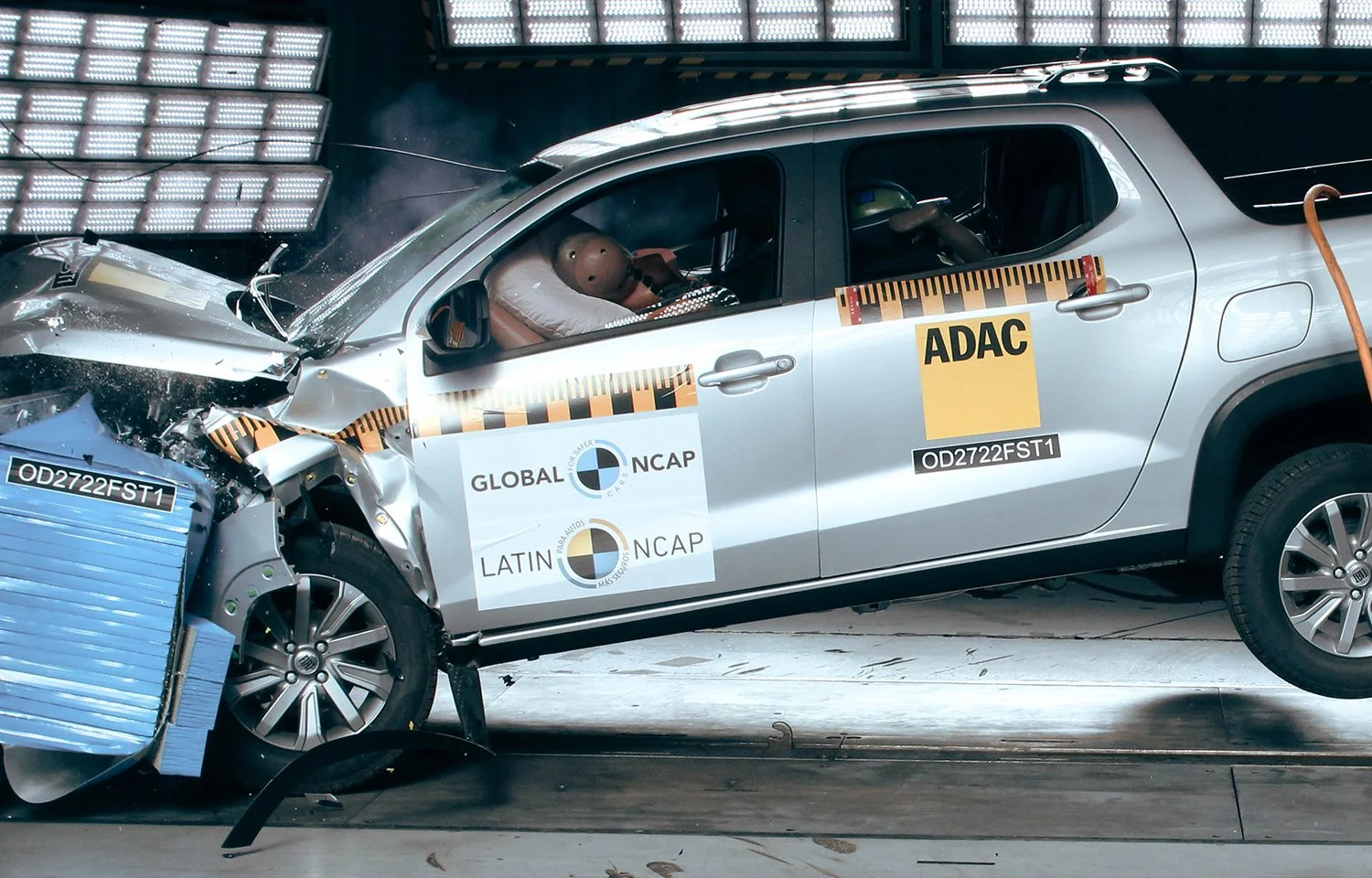Fiat Strada / RAM 700 surprises with only one star
The New Car Assessment Programme for Latin America and the Caribbean, Latin NCAP, third publication for 2022 shows disappointing results for popular model Fiat Strada / Ram 700 scoring only one star, due to, among other things, an unstable structure, poor performing side airbags, differences in the seats between the single and double cab versions for whiplash protection and a lack of safety assistance systems.
The Fiat Strada/Ram 700, produced in Brazil, in its single cab and double cab version achieved only one star. The single cab version with two frontal airbags and Electronic Stability Control (ESC) as standard achieved 47.47% in Adult Occupant protection, 22.08% in Child Occupant protection, 40.23% for Pedestrian and Vulnerable Road User protection and 41.86% for Safety Assist. The double cab version with four airbags, two frontal and two side head-thorax airbags and ESC as standard achieved 41.39% in Adult Occupant protection, 52.96% in Child Occupant protection, 40.23% for Pedestrian and Vulnerable Road User protection and 48.84% for Safety Assist. The worst performing of both versions represents the result of the model, in this case both versions were rated with one star.
The frontal impact showed unstable structure and unstable footwell area. Side airbags, only standard in the double cabin version, showed incorrect deployment and reduced size showing poor protection in the dummy readings for head and chest, which means a high probability of life-threatening injuries in the side pole impact scenario and negatively affecting the side impact score. The side airbags performance is a concern for Latin NCAP and shows once more that the presence of safety equipment does not mean its correct performance and proper protection, as it happened before in other models like the Renault Sandero/Logan/Stepway. Whiplash protection showed good protection in the seat of the double cab while it showed poor protection in the seat of the single cab. The seats have relevant differences which surprised Latin NCAP as they were expected to offer the same performance in the whiplash test.
Child Occupant Protection was good during crash tests, but the total score was affected by the lack of i-Size* anchorages and marking, non-availability in all markets where the model is sold of the Child Restraint Systems (CRS) the manufacturer recommended as well as the lack of passenger airbag disabling possibility according to Latin NCAP requirements. Pedestrian Protection showed poor protection to the upper leg. The lack of Autonomous Emergency Braking (AEB), Lane Support Systems (LSS), Blind Spot Detection (BSD) and Speed Limitation Systems explain the low score for Safety Assist. The single cab also lacked of Seatbelt Reminder (SBR) in the passenger seat.
Latin NCAP tests the most basic passive safety specification of the models. When results show concerning performances, Latin NCAP asks the car manufacturer if there are any plans to improve the model and solve any particular issue. Fiat and Ram, from Stellantis, still did not formally reply to Latin NCAP’s questions.
Alejandro Furas, Secretary General of Latin NCAP said:
“Fiat (FCA) once again disappoints with this poor result after the appallingly low performance of the Argo/Cronos from last year. These two models are among the most popular ones in the region. It is a concern that global parts-suppliers are still offering restraint systems without the robustness expected in Latin America for the tested scenarios of Latin NCAP, unlike what they do in other markets like Europe, US and Australia. Stellantis, together with GM and Volkswagen is one of the three car manufacturers that has a crash test facility in the region. While GM and Volkswagen have already steered towards safer cars aiming to 5 star results, Fiat (FCA) has not reached more than one star in the current protocols. Vehicle safety labelling including the Latin NCAP star rating is an effective solution to these market issues aiming to have independently informed consumers choosing safer cars at the time that car manufacturers voluntary improve their models”.
Stephan Brodziak, Latin NCAP Chairman said:
“Such a low result for Stellantis is very bad in terms of vehicle safety. With such a popular model in the region, we can only denounce Stellantis for this practice of discrimination against consumers in Latin America and the Caribbean. We know that Stellantis produces cars with very high safety standards, but given the poor performance shown in Latin NCAP's Fiat Strada/Ram 700 test, we can see that it is incurring in the pernicious practice of double standard to the detriment of not only of the occupants of these vehicles, but of the population in general and in the degradation of the vehicle fleet in the region. Star rated labelling is one of the most efficient solutions for cases of these double standards, we call for the responsibility of the governments of each country to act in this regard”.
*i-Size anchorages: ISOFIX anchorages are rigid Child Restraint Systems (CRS) anchorage points to the vehicle’s structure or part of it. The CRS must have ISOFIX connectors to engage the ISOFIX anchorage points of the car. Each ISOFIX CRSs model must have a list of car models to which this CRS is “vehicle specific”. i-Size is based in ISOFIX concept and approvals but eliminates the “vehicle specific condition” which means that any CRS type approved as i-Size, will be suitable to install it in any car marked as i-Size. i-Size approved CRSs need to meet side impact protection requirements, each CRS indicates size of the passengers (children) and aims to transport them rearwards facing for longer period of time.
Fiat Strada / Ram 700 (single and double cab)
Read the full crash test report
Watch the crash test video
Download crash test images





